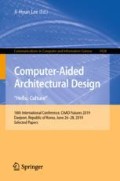Abstract
The use of programming languages in design opens up unexplored and previously unworkable territories, mainly, in conventional architectural practice. In the 1990s, languages of continuity, smoothness and seamlessness dominated the architectural inquiry with the CNC milling machine as its manufacturing tool. Today’s computational design and fabrication technology look at languages of synthesis of fragments or particles, with the 3D printer as its fabrication archetype. Fundamental to this idea is the concept of resolution–the amount of information stored at any localized region. Construction of a shape is then based on multiple regions of resolution. This paper explores a novel design methodology that takes this concept of resolutions on discrete elements as a design driver for architectural practice. This research has been tested primarily through additive manufacturing techniques.
Access this chapter
Tax calculation will be finalised at checkout
Purchases are for personal use only
References
Sharp, J.V., Thompson, D.R.: Method and apparatus for increasing image resolution (1971)
Dillenburger, B., Hansmeyer, M.: The resolution of architecture in the digital age. Commun. Comput. Inf. Sci. 369, 347–357 (2013). https://doi.org/10.1007/978-3-642-38974-0_33
Oxman, R.: Educating the designerly thinker. Des. Stud. 20, 105–122 (1999). https://doi.org/10.1016/S0142-694X(98)00029-5
Carpo, M.: The Second Digital Turn: Design Beyond Intelligence. MIT Press, Cambridge (2017)
Cardoso, D.: Builders of the Vision, p. 208 (2012)
Schumacher, P.: Parametricism: a new global style for architecture and urban design. Archit. Des. 79, 14–23 (2009). https://doi.org/10.1002/ad.912
Carpo, M.: Excessive resolution: from digital streamlining to computational complexity. Archit. Des. 86, 78–83 (2016). https://doi.org/10.1002/ad.2114
Garcia, M.J.: A generalized approach to non-layered fused filament fabrication. In: ACADIA 2017 Disciplines & Disruption, pp. 562–571 (2017)
Retsin, G., Jiménez García, M.: Discrete computational methods for robotic additive manufacturing. In: Fabricate 2017, pp. 178–184 (2017). https://doi.org/10.14324/111.9781787350014
Sanchez, J., Andrasek, A.: Bloom. In: Fabricate 2014, DGO-Digi, pp. 98–103. UCL Press (2017)
Yagel, R., Cohen, D., Kaufman, A., et al.: Volume graphics. Computer (Long Beach Calif) 26, 51–64 (1993). https://doi.org/10.1109/MC.1993.274942
Wu, R., Peng, H., Guimbretière, F., Marschner, S.: Printing arbitrary meshes with a 5DOF wireframe printer. ACM Trans. Graph. 35, 1–9 (2016). https://doi.org/10.1145/2897824.2925966
Mueller, S., Im, S., Gurevich, S., et al.: WirePrint. In: Proceedings of the 27th Annual ACM Symposium on User Interface Software and Technology - UIST 2014, pp. 273–280. ACM Press, New York (2014)
Reynolds, D., Tam, K.-M.M., Otani, R., Poulsen, E.: Equivalent material modelling of complex additive manufactured conformal lattices. In: Proceedings of the IASS Annual Symposium 2017. International Association for Shell and Spatial Structures (IASS), Hamburg, pp. 1–10 (2017)
Pasquarelli, G., Sharples, W., Sharples, C., et al.: Additive manufacturing revolutionizes lightweight gridshells. In: Proceedings of the IASS Annual Symposium 2017. International Association for Shell and Spatial Structures (IASS), Hamburg (2017)
Cheung, K.C.: Digital Cellular Solids: Reconfigurable composite materials. Massachusetts Institute of Technology (2012)
Gibson, L., Ashby, M.: Cellular Solids: Structure and Properties. Cambridge University Press, Cambridge (1999)
Willmann, J., Gramazio, F., Kohler, M., Langenberg, S.: Digital by material. In: Brell-Çokcan, S., Braumann, J. (eds.) Rob | Arch 2012, pp. 12–27. Springer, Vienna (2013). https://doi.org/10.1007/978-3-7091-1465-0_2
Feng, J., Fu, J., Shang, C., et al.: Porous scaffold design by solid T-splines and triply periodic minimal surfaces. Comput. Methods Appl. Mech. Eng. 336, 333–352 (2018). https://doi.org/10.1016/j.cma.2018.03.007
Wang, S., Zhou, L., Luo, Z., et al.: Lightweight of artificial bone models utilizing porous structures and 3D printing. Int. J. Perform. Eng. 13, 633–642 (2017). https://doi.org/10.23940/ijpe.17.05.p8.633642
Yoo, D.J.: Porous scaffold design using the distance field and triply periodic minimal surface models. Biomaterials 32, 7741–7754 (2011). https://doi.org/10.1016/j.biomaterials.2011.07.019
Gibson, L.J.: The mechanical behaviour of cancellous bone. J. Biomech. 18, 317–328 (1985). https://doi.org/10.1016/0021-9290(85)90287-8
Liebschner, M., Wettergreen, M.: Optimization of bone scaffold engineering for load bearing applications. In: Topics in Tissue Engineering Bone II, Part II, vol. 1, chap. 6, pp. 1–39 (2003)
Oxman, N.: Virtual and physical prototyping variable property rapid prototyping. 6, 3–31 (2011). https://doi.org/10.1080/17452759.2011.558588
Fleck, N.A., Deshpande, V.S., Ashby, M.F.: Micro-architectured materials: past, present and future. Proc. R. Soc. A Math. Phys. Eng. Sci. 466, 2495–2516 (2010). https://doi.org/10.1098/rspa.2010.0215
Meagher, D.: Geometric modeling using octree encoding. Comput. Graph. Image Process. 19, 129–147 (1982). https://doi.org/10.1016/0146-664X(82)90104-6
Liu, S., Li, Y., Li, N.: A novel free-hanging 3D printing method for continuous carbon fiber reinforced thermoplastic lattice truss core structures. Mater. Des. 137, 235–244 (2018). https://doi.org/10.1016/j.matdes.2017.10.007
Acknowledgements
The authors would like to thank the following organizations that funded this research; The Frank Ratchye Fund for Art @ the Frontier (FRFAF), Consejo Social de la Universidad Politécnica de Madrid and the National Council of Science and Technology of Mexico.
Author information
Authors and Affiliations
Corresponding author
Editor information
Editors and Affiliations
Rights and permissions
Copyright information
© 2019 Springer Nature Singapore Pte Ltd.
About this paper
Cite this paper
Ladron de Guevara, M., Borunda, L., Krishnamurti, R. (2019). A Multi-resolution Design Methodology Based on Discrete Models. In: Lee, JH. (eds) Computer-Aided Architectural Design. "Hello, Culture". CAAD Futures 2019. Communications in Computer and Information Science, vol 1028. Springer, Singapore. https://doi.org/10.1007/978-981-13-8410-3_7
Download citation
DOI: https://doi.org/10.1007/978-981-13-8410-3_7
Published:
Publisher Name: Springer, Singapore
Print ISBN: 978-981-13-8409-7
Online ISBN: 978-981-13-8410-3
eBook Packages: Computer ScienceComputer Science (R0)

